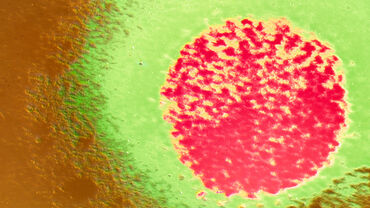Facts about arenavirus
Agent
Arenaviruses are enveloped viruses (about 120 nm diameter) with a bi-segmented negative strand RNA genome. The typical image in electronic microscopy showing grainy ribosomal particles (“arena” in latin) inside the virions gave the name to this family of viruses.
In 1933, the first virus of the Arenaviridae family, the Lymphocytic Choriomeningitis (LCM) virus, was isolated in North America from a human with aseptic meningitis. Other viruses causing hemorrhagic fevers were reported in South America: Machupo in 1956 in the Beni province of Bolivia, Junín in north Argentina, Guanarito in Portuguesa state in Venezuela in 1989, Sabia in Brazil in 1990 and more recently Chapare in 2004 in Bolivia. Lassa fever was identified in Nigeria in 1969.
Distribution
Cases caused by LCM occur worldwide. Thousands of cases of Lassa fever occur each year in Sierra Leone, Liberia, Guinea and Nigeria . However, limited data is available to assess the real incidence of Lassa fever in West Africa. In Southern America, Junín, Machupo, Guanarito and Sabia viruses cause sporadic cases or limited outbreaks.
Clinical symptoms of diseases caused by arenaviruses
Arenaviruses cause diseases with two types of clinical presentations: neurological and hemorrhagic fever. However, asymptomatic arenavirus infection may occur.
Neurological: aseptic meningitis, encephalitis or meningoencephalitis, caused by the LCM virus. Overall case fatality is <1%. Foetal infections can result in congenital abnormalities or death. Immunosuppressed patients, such as organ transplant recipients, can develop fatal hemorrhagic fever-like disease. Transmission of LCMV and an LCMV-like arenaviruses via organ transplantation has been documented.
Viral hemorrhagic fever, Lassa fever usually presents as a non specific illness: with fever, headache, dizziness, asthenia, sore throat, pharyngitis, cough, retrosternal and abdominal pain, and vomiting. In severe forms, facial oedema is associated with hemorrhagic conjunctivitis, moderate bleedings (nose, gums, vagina…), and exanthema. Neurological signs may develop and progress to confusion, convulsion, coma and death. Severe prognosis is associated with a high viraemia, a serum AST level >150 IU/L (aspartate aminotransferase), bleedings, encephalitis and oedema. There is a very high risk of foetal mortality in pregnant women during the third trimester of pregnancy. Case fatality rates range from 5 to 20% for hospitalized cases.
Clinical symptoms of infection by other arenaviruses in South America are similar to those described for Lassa. Case fatality rates may be higher, up to 30% for Guanarito virus, although the available epidemiological data is very limited.
Treatment
Ribavirin treatment has been shown to be efficient for Lassa fever. It is more effective when started within the first 6 days of illness. It is presently contraindicated in pregnancy, although may be warranted if mother’s life is at risk.
Incubation period
The incubation period is about 10 days (3-21 days).
Vaccine
There is currently no vaccine for Lassa fever but several candidates are under development studies with successful trials in primates. One available vaccine is licensed in Argentina for Junín virus.
Reservoir of Arenavirus
Mastomys natalensis (a peridomestic rodent) is the reservoir of Lassa virus. Its geographic distribution is much wider in sub-Saharan Africa that the presently known area of Lassa transmission. The reported incidence of human Lassa fever cases in West African countries is increased during the dry season.
In the New world, Machupo was identified in wild rodent Calomys callosus in Bolivia, Junín from Calomys musculinus and C. laucha in Argentina , Guanarito from a cotton rat (Sigmodon alstoni) in Venezuela. Many other arenaviruses had been identified in the New World including North America (Whitewater Arroyo, Tamiami…) without any link with a recognized disease in humans.
The identification in 2008 of a new arenavirus, Chapare, from a fatal case in Bolivia showed the importance of fully investigating suspect cases of hemorrhagic fever.
Other arenaviruses had been isolated in Africa from rodents without evidence of disease in humans (Mopeia in Mozambique from the same rodent species Mastomys natalensis, Mobala in Central African Republic, Kodoko in Guinea from a shrew… ).
Transmission
Arenaviruses are associated with rodents, their natural hosts. Some of these viruses can be transmitted to humans by contact with faeces/urine from infected rodents or with dust containing infective particles.
They may cause severe diseases with potential risks of human-to-human transmission via body fluids or droplets. Fatal nosocomial and laboratory infections by arenaviruses have been frequently reported. Contamination occurs via direct contact with body fluids or via droplets. Specific procedures were taken from the 1970’s for handling these viruses (now categorized as class 4 agents), including the building of dedicated biosafety laboratories (BSL-4), with containment equipment for all activities involving the virus, infectious or potentially infectious body fluids or tissues.
References
- Anonymous. Case of Lassa fever imported into Germany from Sierra Leone Eurosurveillance 2006 11,7 :191
- Brief report: Lymphocytic choriomeningitis virus transmitted through solid organ transplantation--Massachusetts, 2008. MMWR Morb Mortal Wkly Rep. 2008 Jul 25;57(29):799-801
- Charrel R, De Lamballerie X. Arenaviruses other than Lassa virus. Antiviral Research 57 (2003) 89–100
- Delgado S, Erickson BR, Agudo R, Blair PJ, Vallejo E, Albariño CG, Vargas J, Comer JA, Rollin PE, Ksiazek TG, Olson JG, Nichol ST. Chapare virus, a newly discovered arenavirus isolated from a fatal hemorrhagic fever case in Bolivia. PLoS Pathog. 2008 Apr 18;4(4):e1000047
- Fichet-Calvet E, Lecompte E, Koivogui L, Soropogui B, Doré A, Kourouma F, Sylla O, Daffis S, Koulémou K, Ter Meulen J. Fluctuation of abundance and Lassa virus prevalence in Mastomys natalensis in Guinea, West Africa. Vector Borne Zoonotic Dis. 2007;7(2):119-128
- Klempa B, Fichet-Calvet E, Lecompte E, Auste B, Aniskin V, Meisel H, Barrière P, Koivogui L, ter Meulen J, Krüger DH. Novel hantavirus sequences in Shrew, Guinea. Emerg Infect Dis. 2007 Mar;13(3):520-522
- Palacios G, Druce J, Du L, Tran T, Birch C, Briese T, Conlan S, Quan PL, Hui J, Marshall J, Simons JF, Egholm M, Paddock CD, Shieh WJ, Goldsmith CS, Zaki SR, Catton M, Lipkin WI. A new arenavirus in a cluster of fatal transplant-associated diseases. N Engl J Med. 2008 Mar 6;358(10):991-998





